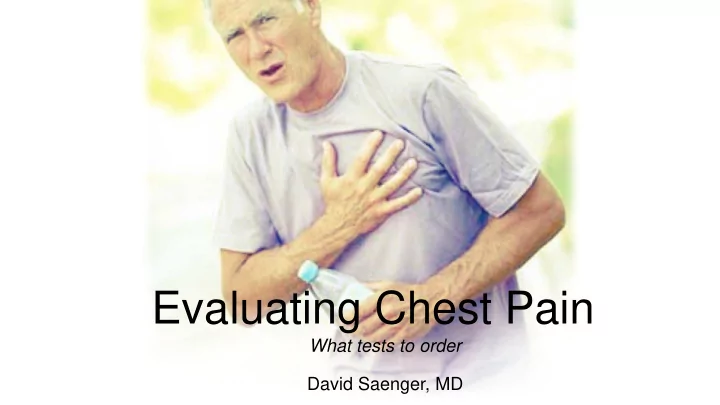

Evaluating Chest Pain What tests to order David Saenger, MD
Disclosures I have nothing to disclose •
Chest pain is EASY! Most chest pain can be sorted out into cardiac/non-cardiac by • history alone Stress testing is not always necessary • If it’s clearly angina, just treat it and refer (if appropriate) • High risk patients should often (not always) go directly to • cardiac cath
When do I need to order a stress test? The goal of stress testing should be to identify high risk • patients These are patients who have a bad prognosis without • treatment and whose prognosis will improve with treatment. Plain exercise treadmill testing is under-utilized, safe, cheap, • and provides valuable information. Sometimes stress testing with imaging is useful. •
Definition of ANGINA Occurring with exercise (or emotional stress) and relieved with • rest (or nitroglycerin) Lasting about 5-10 minutes • Of a certain typical quality • Vague (not pinpoint), often radiating • May be associated with diaphoresis, nausea, dyspnea •
Clinical Classification of Chest Pain
Stable Angina Stable angina • Fixed restriction in myocardial oxygen supply, causing • variable supply/demand mismatch with changes in demand Unstable angina is different • Change in myocardial oxygen supply , causing a change in • symptoms or symptoms at rest
Unstable angina … Acute coronary syndrome …NSTEMI These imply an active, dynamic situation , usually caused by • plaque erosion and impending (or actual) MI. These are managed in the ED or hospital, where a defibrillator • is nearby, IV access is obtained, etc. A totally different situation. Not covered here, except to say: • NEVER, EVER, EVER send a troponin lab from the office •
Why not send a troponin from the office? • Doing so implies that you have decided to treat a life- threatening medical emergency without any of the necessary supports which are standard of care in this situation. • You are therefore assuming responsibility for whatever happens next. • Good luck with that.
Unstable angina spans a spectrum of disease Changing pattern of angina in an otherwise stable patient can • be evaluated as an outpatient Oregon Cardiology’s new Rapid Access Clinic can see non- • emergent but urgent chest pain within 24-48 hours
I just want to know if my patient’s chest pain is cardiac Pre-test probability of having CAD will change the likelihood of • disease. Not all patients should have the same test for chest pain •
What about women? A recent large review study in JAMA Internal Medicine showed • that men and women with stable angina largely present with the same symptoms Women did tend to use different words than men. Women • more often used terms like “pressure”, “discomfort” and “ache” Women do more frequently have atypical symptoms with • acute MI , compared to men
What does this mean? A negative result on a stress test for a high-risk patient hasn’t • helped very much. A positive result on a stress test for a low-risk patient hasn’t • helped very much. Diagnostic tests with average sensitivity/specificity are most • useful in intermediate risk patients
So, which test should I order? How badly do you need to know? • Should everyone just get an angiogram? • Let’s shift gears for a moment and discuss the clinical impact • of CAD in your individual patient
What is the annual mortality for single-vessel CAD? 1%? • 2%? • 10%? • 20%? •
CAD mortality About 1% per vessel per year! • Except for Left Main and 3 vessel disease, which are 4- • 8%/year
The main point of stress testing is to identify patients with severe CAD Multi-vessel and Left Main CAD will realize a mortality benefit • from CABG or PCI These are the patients who have potential for mortality • reduction from the CAD diagnosis And these are the patients we most want to find with stress • testing
The prognostic result of stress testing is (maybe) more important than the diagnostic This is why not every positive stress test needs a cath • Need to cath only if it will affect prognosis and if • revascularization will affect prognosis Medical therapy without cath for a patient with single vessel • CAD is OK
Which patients are best for plain treadmill? • Low-intermediate likelihood of CAD • “Normal” EKG at rest • RBBB OK, but no LBBB and no ST depression at rest • Able to exercise • This is actually probably the majority of patients
Which patients are best for nuclear MPI? • Prior history of CAD, especially history of CABG or PCI • MPI will localize the ischemia • Can’t exercise or • Might not be able to exercise but can try • Bail-out Lexiscan • LBBB • Pacemaker
Which patients are best for stress echo? • Intermediate likelihood of CAD • Can exercise • Likely to have good imaging • Not very obese, COPD
What about women? • Exercise stress testing is somewhat less specific in women • Specificity in men 77% versus 70% in women • This means that women will have more false positive results • This also means that the Negative predictive value of an exercise treadmill test is just as good in women.
Stress testing in women • Because sensitivity is just as good in women as men, guidelines still recommend exercise stress testing in women as the best initial test. • Prognostic data regarding exercise duration is just as valid for women as for men. • The Duke Treadmill Score is just as valid for women
Recommend
More recommend